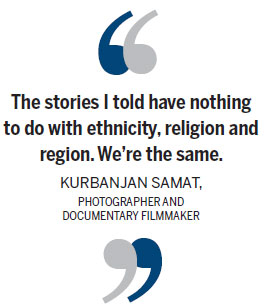Fighting stereotypes
Updated: 2015-09-25 08:03
By Cheng Lu and Wen Chihua(China Daily Europe)
|
|||||||||||
|
Kurbanjan Samat wants to use his photos to fight prejudice against people from the Xinjiang Uygur autonomous region. Wen Chihua / For China Daily |
Former boxer is using his camera to share Xinjiang culture and dispel misconceptions
When amateur boxer Kurbanjan Samat bought his first camera, he started using photos rather than his fists to fight the misconceptions in China surrounding people from the Xinjiang Uygur autonomous region.
"You're thought of first and foremost as a barbecue cook, nutcake vendor, thief or terrorist if you're from Xinjiang," the 33-year-old photographer and documentary filmmaker says, referring to perceptions of people from the northwest corner of China.
After several terrorism incidents in Xinjiang and elsewhere perpetrated by Uygur separatists, people like Samat have joined the government in wanting to address these stereotypes, especially ahead of the region's 60th anniversary in October.
"If you don't stand up to fight the labels, they may fall on your own head sooner or later," he says. "What happened to Henan people 10 years ago (when the province was tagged as the center of counterfeit currency) is now happening in Xinjiang. Applying broad labels to entire groups of people only reinforces irrational behavior."
Samat has released a collection of his photos, I Am From Xinjiang, which tells the stories of 100 Xinjiang people of various ethnicities and professions across China. After receiving a positive response to the Chinese and English versions, translations in Arabic, Turkish and Japanese are in the pipeline, and he is also raising money to make the work into a documentary.
Explaining his motivation, he points to an online comment by a child from Henan who wrote that he has never been to Xinjiang but supports what Samat is doing because he knows what it is like to combat stereotypes - in his case that Henan people are liars.
"People are more or less biased and have a tendency to label a certain group after a certain incident," the former boxer says. "The stories I told have nothing to do with ethnicity, religion and region. We're the same."
Critics have argued that what is impressive is not Samat's images, but the stories behind them. Each is accompanied by a biography of their subject.
And Samat's back story is no less interesting. He was born in Hotan prefecture, which is known for nephrite, a type of soft and warm jade. Yet his character is just the opposite, sharp and cool.
His 60-year-old father, a jade businessman who had visited inland cities in the 1980s, understood the importance of education and had Samat and his siblings change schools three times for a better education.
Even from a young age Samat says he would stand up for his principles, often with violence. He believed fists could conquer all and began learning to box at 16. "I trained for four months and beat up a guy who had slapped me in front of some girls," he laughs.
His love of photography began "accidentally" in 1999. He was planning to spend his savings on a guitar to charm the girls at school but instead became captivated by a camera shop's display on his way to the guitar store. He went in, bought his first SLR and has been obsessed with taking pictures of the beautiful landscape and diverse culture in Xinjiang ever since.
In 2006, he went to Beijing in search of a job and a better life. He met his wife, an ethnic Uygur born in the Chinese capital, and orchestrated a number of award-winning photo exhibitions and participated in the shooting of documentary films. But he says he was troubled by one problem - people's lack of understanding of Xinjiang.
At first, the quick-tempered filmmaker continued to use his fists when he heard anyone speaking ill of his home. But he says a deadly riot in Urumqi, the regional capital, on July 5, 2009, left him shocked, and he "came to realize that fists can't solve all problems".
Several months after the riot, as mistrust of the people in Xinjiang grew, his landlord kicked him out of his rental apartment in Beijing. Standing in the street, he was angry and helpless. He had no place to go and no friends to turn to. He bought his first pack of cigarettes and puffed away on one after another through the night.
"Why can't people understand that a few bad apples cannot represent all Uygurs, and Uygurs cannot represent all of Xinjiang?" he asks.
In addition to 40 percent of the regional population being Han, the largest ethnic group in China, Xinjiang is also home to Kazaks, Mongols and Tajiks.
Today's Top News
Opinion: Opportunity knocks for EU and China over next five years
Yuan rises for 7th day in a row, highest level since August
Reforms spark legal brain drain
EU officials postpone visit to Turkey after attacks in Ankara
Documents of Nanjing Massacre inscribed on Memory of World Register
Xi congratulates Kim on WPK anniversary
CPC expels media exec over UK 'green card'
Chinese students' print-like English handwriting stirs controversy
Hot Topics
Lunar probe , China growth forecasts, Emission rules get tougher, China seen through 'colored lens', International board,
Editor's Picks

|

|

|

|

|

|








